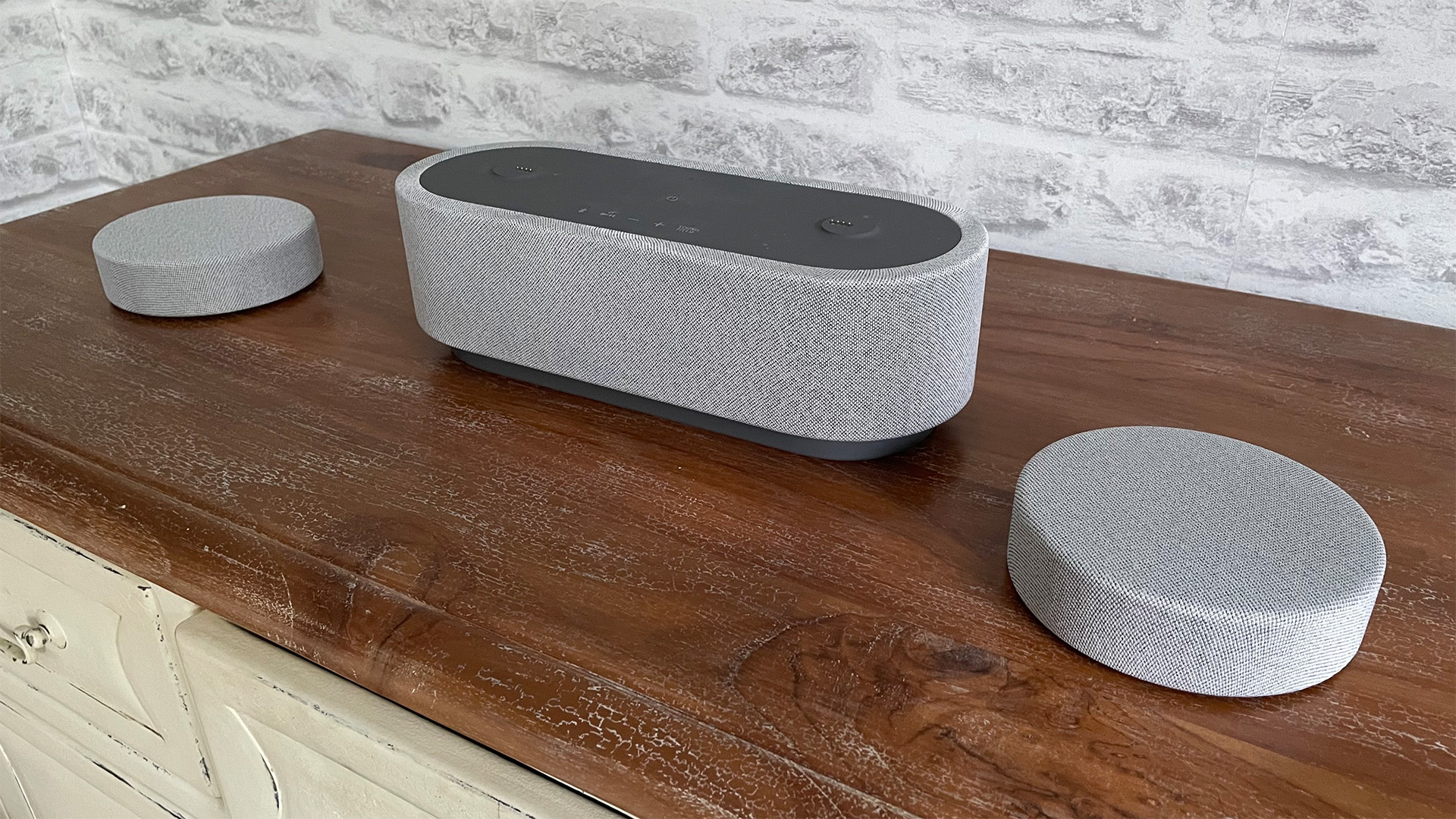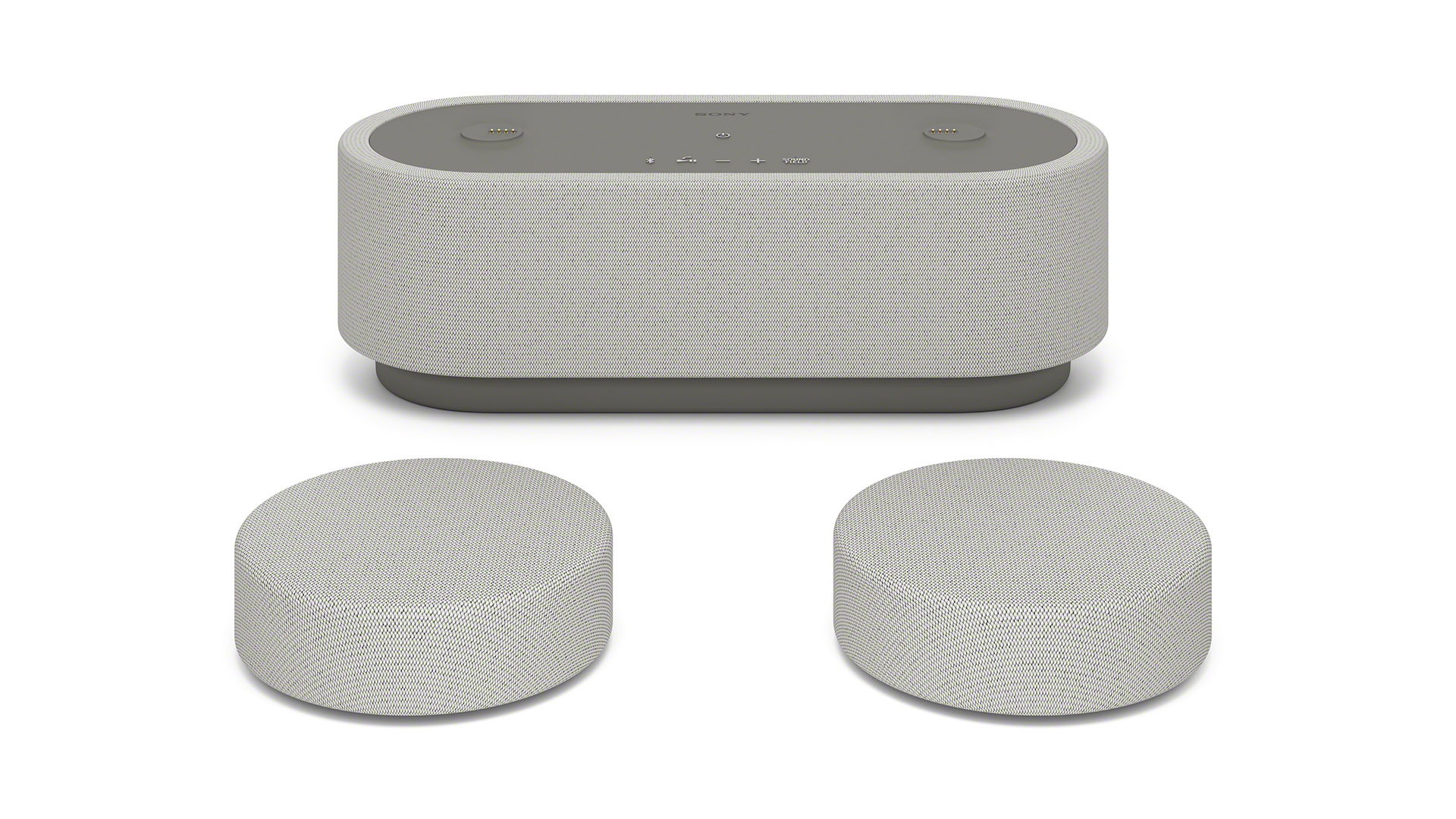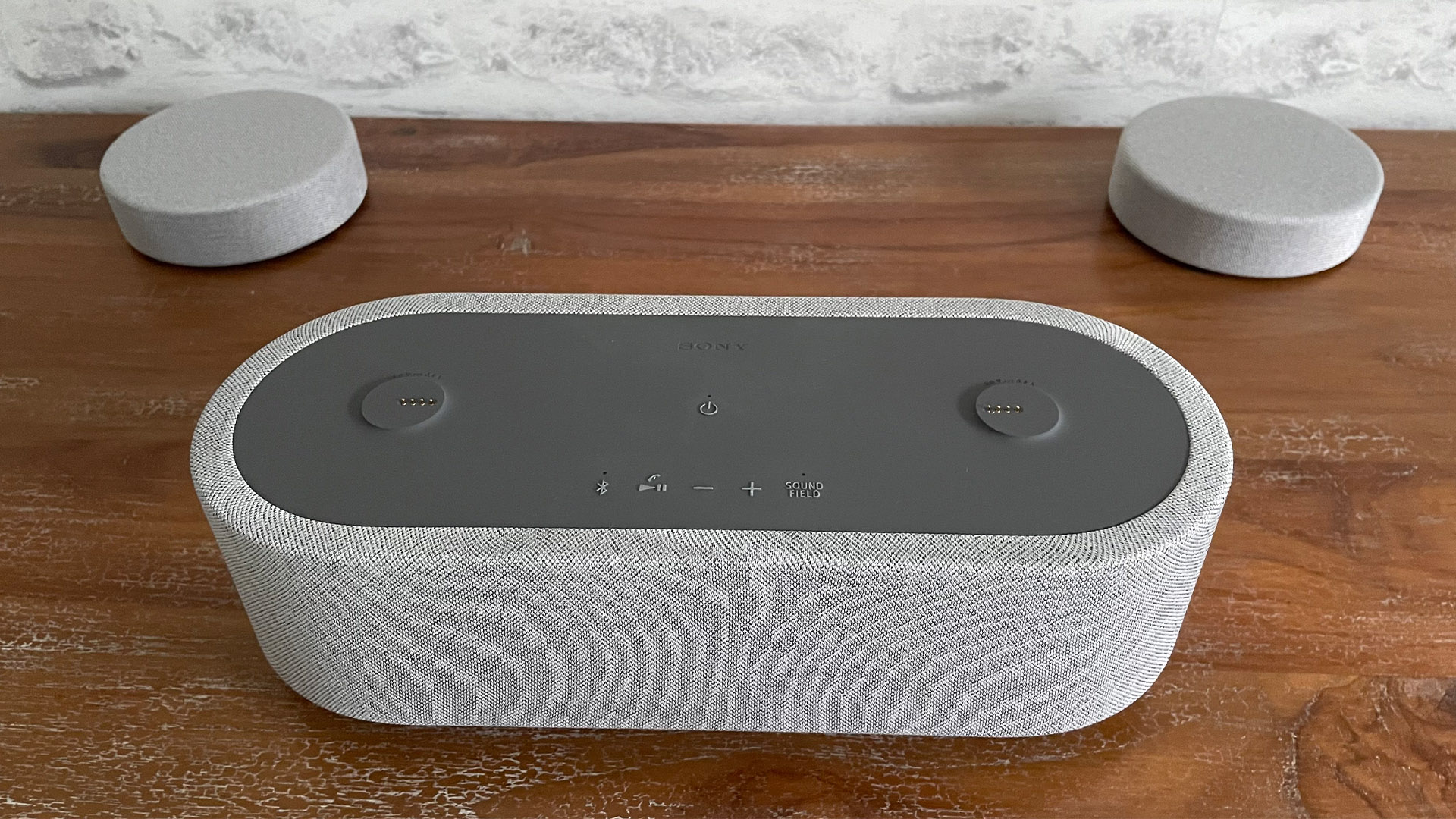What Hi-Fi? Verdict
While it’s unique and interesting, the HT-AX7 doesn’t entirely satisfy as either a home cinema device or Bluetooth speaker for music
Pros
- +
Compact, attractive and ingenious design
- +
Can create a convincing 360-degree sound
- +
Crisp, detailed sound
Cons
- -
No HDMI or wi-fi connectivity
- -
Small speakers can distort
- -
Limited dynamic range
Why you can trust What Hi-Fi?
We’ve come across all sorts of weird and wonderful (and not so wonderful) products over our decades of venturing into the more esoteric parts of the hi-fi world. Few if any, though, have caused quite as much head-scratching at What Hi-Fi? towers as the Sony HT-AX7.
The HT-AX7 is small enough to be a portable music speaker. But two discs attached to its top edge suggest something else is going on.
It turns out that those discs can be detached to become separate wireless speakers. So maybe the AX7 is an unusually small soundbar? Except that it doesn’t have any physical source connections or even wi-fi connectivity. Also, while it supports Sony’s 360-degree spatial sound technology, it doesn’t support Dolby Atmos or DTS:X. So… maybe it’s an immersive surround sound music player? Except that Sony itself calls it a portable theatre system. Confused? You should be…
Price

The Sony HT-AX7’s identity crisis plays out in its price. If you think of it as a personal/portable music speaker, its £499 / $500 (around AU$635) asking price makes it a pretty premium affair. Yet if it turns out the AX7 is effectively a dinky soundbar, that price would make it seem reasonably affordable (though certainly not ‘bargain bucket’) by regular soundbar standards.
If it turns out to be a personal home theatre or 360-degree surround sound music system then, honestly, there isn’t much of a frame of reference to draw on when deciding if it is good value or not. It will depend on a) how convincing a case it makes for whatever it most ends up appearing to be, and b) how good it ultimately sounds.
Design

The Sony HT-AX7 is certainly a unique looker. In its ‘joined up’ state it comprises an eclair-shaped, fabric-covered base unit around 30cm long, 10cm high and 12cm deep, with two 3.9 x 12 x 12cm (hwd) circular speakers sitting tidily on top of each end of the base unit eclair.
A gap/seam between the circular speakers and the base unit makes it clear that these speakers can be detached from the base. In fact, while they can attach to the bass unit using a slick magnetic mechanism for recharging, or be left sitting on the main unit if you just want a simple stereo sound, the disc speakers are intended to be removed and placed either behind you, to form a surround sound experience, or scattered around a room to create a ‘party’ sound experience.
The latest hi-fi, home cinema and tech news, reviews, buying advice and deals, direct to your inbox.
All three speakers are finished in a light grey(ish), wrap-around fabric, and build quality is excellent across all three parts of the system. The circular design of the power connector on the underside of the two detachable speaker discs is genius, too, as it saves you from having to tediously line up more specific connection points.
The top edge of the base unit is the only visible part of the system that doesn’t sport the greyish fabric finish, switching instead to a slightly rubberised smooth grey finish from which a selection of control buttons tastefully protrude.
Unexpectedly the HT-AX7 doesn’t ship with a remote control, while the only physical connection across the whole system is a USB-C recharging port on the main base unit.
Features

We do really need to get to the bottom of what exactly the HT-AX7 is all about. So let’s put our Sherlock Holmes hat on and see what we’ve got.
After lots (and lots) of experimentation with the placement of the HT-AX7’s three speakers, lots of playing around with its sound modes and lots of experimentation with different types of source, in the end, our conclusion is that – strange though it sounds – Sony’s own description of it as a Portable Theatre System probably gets closest to the mark.

Power 51W
Bluetooth? Yes (5.2)
Wi-fi? Yes
Mains-powered or battery powered? Battery-powered
Battery life 30 hours
Features Three-piece system, two wireless rear or ‘party’ speakers dock onto the main unit for charging, Sound Field 360 Spatial Sound setting, Night mode, voice mode, Home Entertainment Connect app control
Connections USB-C charge port
App? Yes
Dimensions (hwd) Main unit: 9.7 x 31 x 12cm; detachable speakers: 3.9 x 12 x 12cm
Weight 2kg total
Finishes grey fabric
Sony’s guide for the AX7 essentially describes/recommends two different set-up scenarios. One ‘room-filling mode’ where the two detachable disc speakers can be placed pretty much anywhere, regardless of where the main speaker is, and one where you place the three speakers in a more or less triangular configuration around, with each one around a metre or so away from your seating position.
The room-filling mode kicks in if you turn off the AX7’s Sound Field effect audio mode, and essentially sees all three speakers outputting the same sound, so that music is simply spread more evenly around your room/house for parties. Much more intriguing and effective, though, is the surround sound ‘triangle’ effect you get with the Sound Field mode on.
This brings Sony’s 360 Spatial Sound Mapping system into play, for starters, where the Sony analyses the acoustic properties of your room and the three components relative to one another and creates ‘virtual’ speaker points that make you feel as though you’re wrapped in a bubble of sound.
While the AX7 doesn’t support Dolby Atmos or DTS:X decoding, its audio processing does seem to respond differently for movie and music use. The movie mode essentially translates multi-channel mixes to Sony’s 360 Spatial Sound system, while the music mode converts even simple stereo sound into a full surround-sound mix that integrates into the 360 Spatial Sound audio ‘dome’.
You can elect not to detach the circular speakers from the main speaker if you want to enjoy a more standard portable music speaker playback experience. While this may be a worthwhile option for stereo enthusiasts not enticed by the idea of Sony’s 360 Spatial Sound remixing, though, if you’re not regularly going to use the AX7’s full speaker complement, there probably isn’t much point spending this amount of money on it.
Even if you love the idea of the detachable speakers, you will still have to attach them to the main unit fairly frequently since this is the only way to recharge their batteries. Sony claims up to 30 hours of continual use (depending on volume) from the three speakers on a full charge. For yes, the main unit is battery powered too. The main speaker unit takes around four hours to fully charge, with the two detachable speakers taking around four and a half hours.
Sony also claims you can get enough charge into the system from a mere 10 minutes of mains connection to deliver 150 minutes of use. Not quite enough for a full run-through of Titanic, but enough for most mainstream movies. Or multiple music albums.
A hunt for connections on the HT-AX7 leaves us remarkably empty-handed. All you get is the USB-C power port on the main unit. There’s no optical digital or 3.5mm audio input, no USB port for adding a USB storage device, and no HDMI input for perhaps attaching a TV via eARC.
It’s not just the physical connections that are limited; there’s no wi-fi connectivity either. In fact, the only way of getting sound into the AX7 is Bluetooth (version 5.2), using the AAC and SBC formats. It is possible to stream audio via Bluetooth from TVs these days, of course. But to us, only supporting Bluetooth together with Sony’s description of the AX7 as a portable theatre all points to Sony envisaging its speaker system being most often used with other portable devices, such as laptops, tablets and smartphones. A supposition backed up, as we’ll see shortly, by how the system performs in different configurations.
The main ‘front’ speaker in the AX7 package features two front-firing Sony X-Balanced speakers, which use an elongated rectangular shape to deliver more volume and clarity from relatively small drivers. Two passive radiators are tucked behind the main speaker’s curved ends – though despite the wraparound felt finish, there aren’t any speakers on the rear side. Power comes, as we’d expect, via Sony S-Master amps.
As we noted earlier, the HT-AX7 doesn’t ship with a remote control. The only ways to control it are the raised buttons on the main unit’s top edge and Sony’s Home Entertainment Connect app for Android and iOS. The buttons on the main unit are nice and tactile, at least, and while the app is rather basic it gets the job done.
The only other features of note are a Night Mode that limits the speaker’s dynamic range so as not to disturb other people late at night, and a Voice Mode that puts more emphasis on dialogue tracks.
Sound

How good the Sony HT-AX7 sounds depends on a number of factors and, in the end, these join the minimal connectivity to really limit the speaker’s usefulness.
For starters, the effectiveness of the 360 Spatial Sound effect depends quite precisely on how far from your seating position the three speakers are placed. For the most seamless, ‘joined up’ 360-degree effect you really should follow Sony’s advice and place the rears not much more than 1-1.2 metres or so away from your seating position. Examples given by Sony show the rear speakers sitting on the back of your sofa with the main speaker on a coffee table, or a person lying or sitting on their bed with the main speaker in front of them and the circular speakers on the bed behind them or to either side of their seating position.
If you try and spread the ‘triangle’ of speakers out too far, palpable gaps open up in the surround-sound hemisphere, and noticeable disparities appear between the power and projection of each ‘surround’ speaker versus the meatier main unit.
This all rams home what a ‘personal’ sound system the AX7 truly is. You might just, if you feel like getting really cosy, fit two people within the AX7’s effective working space, but in reality its scope seems to be limited to a one-person set-up.
This distinct spatial limitation to the AX7 means that you can’t really use it as a regular surround-sound soundbar, with the main speaker under your TV and the two circular speakers sitting behind you. Unless, anyway, your seating position is far closer to the screen than usual. We guess maybe there’s the possibility of using the AX7 as the audio system in a second-room gaming set-up if you can find somewhere behind your shoulders to put the circular speakers – but as a main living room soundbar it’s a bust.
It’s also pretty much a bust for music fans wanting to enjoy their favourite tracks in surround sound unless they’re committed to sitting or lying more or less still within the system’s limited effective area. You can’t walk around your room casually listening to music with the surround-sound Sound Field system in play as you might with a regular portable/wireless speaker – or if you were wearing a pair of wireless headphones. Pop the circular speakers onto the main unit and a more casual use-case becomes possible – but again, at that point you’re not using the three-component feature that makes the AX7 so expensive.
We’re still not done with the set-up limitations of the AX7 yet, either. Sony’s own presented use-examples show the system set up around someone watching a film or TV show on a tablet they’re holding in their hand, with the main speaker unit by their feet. Our own experiments confirm that within the AX7’s limited effective operational space as a surround system, using a tablet, laptop or even a phone held in your hand or on your lap works best as your viewing device when using the AX7 as a portable theatre system. This means, though, that the main front sound is actually coming from a position some distance behind your screen, rather than in front of or level with the screen as would happen with a regular soundbar set-up. The sound thus appears dislocated from the visuals you’re watching on your portable device.
There’s a scale issue, too, where the AX7’s sound seems actually too big for the scale of the small-screen visuals you’re likely watching. We guess this points to some strengths of the AX7’s audio, but by not sounding personal enough, the scale of the sound actually adds to the sense of dislocation from the visuals.
This is especially ironic because the HT-AX7 is at its best in sound quality terms as a surround sound movie system. The general sense of surround staging with Dolby Atmos, DTS:X and lower-quality surround formats is pretty effective with the speakers arranged in the compact array we’ve described, generating a surprisingly well-connected and immersive dome of sound around you that even has a sense of height to go with its left to right and front to back credibility. With the opening scene of It Chapter One, for instance, it convincingly creates the sense of raindrops coming from above as well as all around you. And this height element comes from the little rears as well as the chunkier main unit, completing the feeling that you’re in the middle of a true dome of sound.
Sony’s 360 Spatial Surround system really is very clever at this sort of stuff – and yes, the sense of space the system creates is an upgrade in some ways on the effect you get from good ‘surround sound’ headphones.

The power and impact from the AX7’s three speaker components exceed expectations raised by the system’s size, too, with even the heavy percussive beat at the start of chapter two of Blade Runner 2049 on 4K Blu-ray sounding potent and convincing to a degree that leaves any built-in TV sound system for dead.
The effectiveness of this Blade Runner effort owes some debt, too, to the AX7’s surprisingly impressive bass performance. It reaches lower frequencies than you’d imagine possible from its compact size, and hops quite nimbly between different bass frequencies.
Vocals sound credible and clear without losing context, and there’s lots of clean, well-balanced detail in the AX7’s presentation of movie mixes too. Transitions are typically handled tidily and accurately despite the system having to ‘adapt’ surround-sound mixes into its 360 Spatial Sound format rather than natively decoding Dolby Atmos or DTS:X soundtracks. Treble details don’t become harsh or shrill either and, to a point, the rear speakers’ tone fits quite nicely with that of the main unit.
We say ‘to a point’ because if you push the volume really high during dense soundtrack moments, the rear speakers start to sound a bit congested and wispy versus the meatier main unit. We also feel the need to crank the rear speakers up three or four volume levels relative to the main speaker to make their presence felt, despite the cleverness elsewhere of the 360 Spatial Sound system.
Finally where the AX7’s movie performance is concerned, the system doesn’t have quite enough power to keep escalating its sound all the way to the crescendo of the movie world’s loudest moments, leaving such ‘peak’ sound moments falling a little flat.
Using the HT-AX7 in surround mode with music is more of a mixed bag. The good news is that the Sound Field mode does in general do a good – or at least, interesting – job of ‘remixing’ stereo music into Sony’s 360 Spatial Sound environment. The way elements in the mix are shared around the three speakers is remarkably intelligent in the understanding it shows of what really needs to remain locked to the front speaker – including well-staged and clear vocals – and what can be mixed to the back to create a more ambient or ‘arena-like’ effect. There’s even a quite compelling sense of height with some particularly soaring tracks.
The sound in each rear is not the same, either; you can clearly hear effects panning across the rear and different effects being presented from over your left and right shoulders.
The effectiveness of the 360 remixing is dependent, though, on the type of music you’re listening to. If a track is relatively sparse or innately atmospheric, such as Nick Cave’s Red Right Hand or Björk’s Bachelorette and All Is Full Of Love, it translates into the AX7’s surround domain really effectively. Even relatively sparse guitar-led tracks such as Sonic Youth’s 100% sound at least interesting when turned into surround tracks, even if the rears start to slightly dominate.
Denser, more layered music, though, such as heavier rock and some orchestra tracks, can start to sound slightly dirgy and forced with the Sound Field mode active. Also, we found ourselves manually tweaking the relative volume of the rear speakers almost track by track while listening to music in surround mode in a bid to try and keep the 360-degree surround effect intact. Not exactly the relaxing sit-back musical experience some people will be looking for.
The rears are more likely to distort with dense music than they do with movie mixes, too, and the 360 Spatial Sound effect creates slightly less convincing results with Dolby Atmos song mixes than it does from basic stereo. Finally, the AX7 needs to be running quite loudly. Otherwise, its sound tends to shrink down into itself when the going gets tough.
Popping the circular speakers back onto the main unit so that the system becomes a more conventional portable wireless speaker achieves solid results. There’s that familiar detailed, dynamic and open quality to the sound we’ve come to expect from Sony S-Master amps and X-Balanced speakers, and the sound spreads a nice distance beyond the speaker’s physical confines without losing cohesion.
The stereo effect is therefore both more pronounced and tight in its effect positioning than we’d normally expect to hear from such a compact unit.
The AX7’s tone can start to become a touch shrill in stereo mode, though, while at the other end of the spectrum, bass sounds more limited in scope than it does when playing film soundtracks.
In the end, the Sony HT-AX7 sounds perfectly pleasant as a regular wireless portable music speaker – but that’s not enough to make it a serious competitor for the best portable speakers around at this price level.
Verdict

There are strong elements to the HT-AX7’s sound and design, as we’d expect from Sony. It really does try to do something no other products offer in quite the same way, too. However, its unique approach to personal and portable sound comes with strings attached and, in the end, while we laud Sony for trying to do something new, the HT-AX7 ultimately feels like an attempt to solve a problem that doesn’t really exist.
SCORES
- Sound 3
- Features 4
- Build 5
MORE:
Read our review of the Audio Pro C20
Also consider the JBL Authentics 500
Read our Sonos Move 2 review
Best wireless speakers tried and tested by our expert team
What Hi-Fi?, founded in 1976, is the world's leading independent guide to buying and owning hi-fi and home entertainment products. Our comprehensive tests help you buy the very best for your money, with our advice sections giving you step-by-step information on how to get even more from your music and movies. Everything is tested by our dedicated team of in-house reviewers in our custom-built test rooms in London, Reading and Bath. Our coveted five-star rating and Awards are recognised all over the world as the ultimate seal of approval, so you can buy with absolute confidence.


